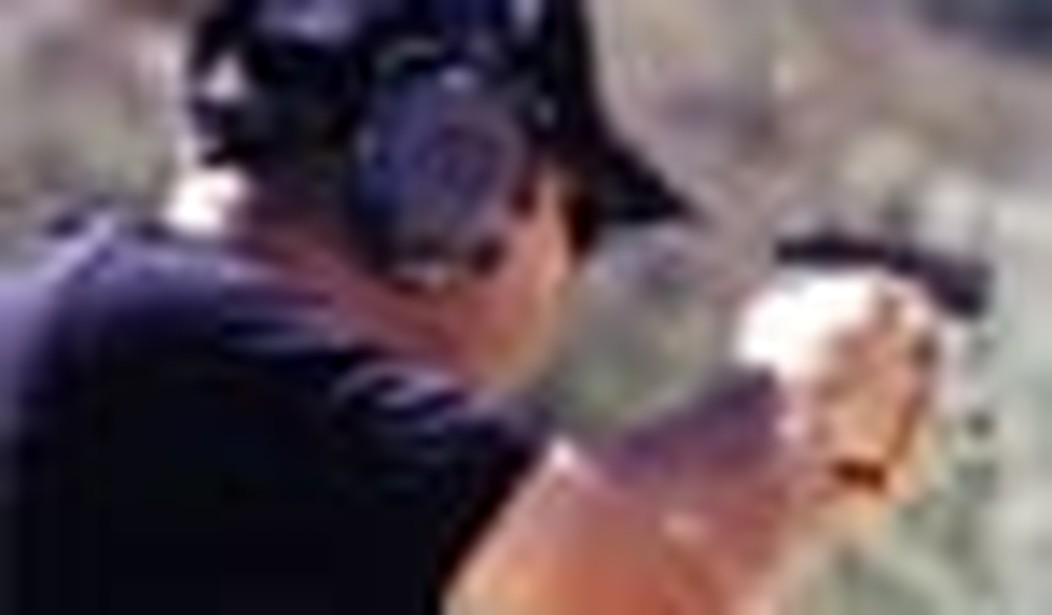I spent a recent weekend at the Wake County Firearms Education and Training Center, taking the NRA’s Personal Protection Outside the Home (PPOH) course. It is a handgun shooting course that focuses, strangely enough, on defensive shooting outside the home, out in the “real world.” Roughly one-third of the students in the class were NRA instructors of one kind or another. All of us had concealed carry permits.
After a Saturday morning in the classroom, we spent Saturday afternoon and all of Sunday morning on the firing line.
We shot from contact distance (so close the targets were singed by burning powder), out to a maximum range of ten yards. We engaged most targets between 3-5 yards, as would be typical in most scenarios one might encounter. Drills were fired using single shots and double taps, to the rarer “empty the gun” drills. Targets at the indoor range were engaged under normal lighting conditions to nearly complete darkness, where all we could make out was the rough silhouette of the target three yards away.
It was mentally and physically exhausting, but well worth it. We walked away from the experience with solid training under our belts and a wide range of new training exercises to employ. Several members of the class were back again the following weekend to receive their instructor ratings for this course, the most advanced defensive pistol course the NRA offers.
While we were completing our second day course of fire, there was a concealed carry class (like the one I wrote about for PJM two years ago) taking place in the other classroom at the range. When we came off the firing line and came back into the lobby between the classrooms, they were taking a break from the lecture portion of the course. Many students seemed to be suffering from lesson-inspired shell shock. The amount of practical carry information and legalese being thrust upon them in one day’s time was intense, and several looked like they had simply had enough. Within an hour, it would be their turn to exit the classroom and set foot upon the range for the rather minimal shooting qualifications our state requires.
They would spend roughly 1-2 hours on the range completing a prescribed course of fire under the watchful eyes of their instructors. They would not be graded upon how quickly or accurately they placed their shots on target, but upon a far more basic criteria: did they employ their handgun safely, without sweeping other students with the barrel of their gun?
A shooter who peppers five shots all over the target over the course of 20 seconds — abysmally slow by most any measure — would pass the course just as well as the shooter who put all of his shots in the ten-ring in a quarter of that time. The on-range portion of the concealed carry course was designed to make certain the student has basic safety skills … and that was all. But was that bare minimum of competence a student needs to pass the carry course range qualifications “enough” training?
After all, performing simple, measured tasks in highly restricted, heavily coached conditions is hardly the same thing as mastery of the skills a carry permit holder may be called upon to employ in the real world. People don’t stand still and wait for you to shoot at them, and you won’t be able to raise your hand and have an instructor clear your weapon if you have a failure to fire.
Collectively, our PPOH class had fired hundreds of thousands of rounds of ammunition, and more than 1,600 over the weekend’s training alone. We knew from our our experiences that the students completing the carry course would not likely finish a single box of shells that day and that many would probably not fire their guns again in the weeks, months, and years ahead, even if they attained their permits and even if they decided to carry a handgun frequently.
As shooters, students, and instructors, this concerned us.
Don’t get me wrong — I doubt anyone in our class would be comfortable being called an “expert.” None were competition-grade shooters, and we had quite different styles. Most were old-school practical marksmen who methodically carved ragged holes dead-center in the middle of their targets. Their draw was a bit slower, their posture rigid, and their magazine changes were on the slow side because they would rather pocket empty magazines than drop them. Their approach revealed years of range time carefully honed using classic stances, and it worked for them.
Some of us were faster on the draw and quick on the trigger. We didn’t concentrate on specific shot placement as much as getting several shots on the torso of the target quickly. Our magazines clanged off the floor as we dropped empties and reloaded with full mags as quickly as possible, crouched low behind cover and mimicking the more combat-minded practical schools of shooting more recently in vogue.
Of the eight shooters in our class, only one shooter was truly marginal — an older man with shaking hands who couldn’t master his Glock’s magazine release, nor keep from jerking the trigger when he got nervous. While he was the least talented of our group, he was still far more capable than the law required.
As we reassembled in our classroom to pick up our PPOH Basic and Advanced certifications, one of the instructor/students asked our senior course instructor whether or not he felt there should be more stringent requirements regarding the shooting skills and safe gun-handling of concealed carry permit holders. Our state’s concealed carry course is far less stringent than some, even as it requires more knowledge of the law than others, including states that don’t require any sort of permit or competency testing at all.
It was a question that pained him, and he took time to carefully articulate why he didn’t think carry requirements should be more exacting, even as he advocated more training for all.
Everyone seems to remember the clause in the Second Amendment about the “right to keep and bear arms,” and it was because of this right that he had a hard time suggesting that we needed a more complicated or intensive permitting process. At the same time, there is a clause in the Second Amendment that details that our nation’s security is derived not just from having the right to arms, but from being “well-regulated.”
That phrase, uttered in the context of the time in which it was written, did not mean we needed more laws and regulations. It meant that shooters must be well-trained. Skilled shooters with access to familiar arms are liberty’s insurance. A man who owns a gun but who does not develop and keep honed his competence is not participating in the martial pursuits that the Founders envisioned as being necessary to the security of a free state.
In the end, he felt everyone should participate in training, but that it shouldn’t be legislated. We should all have the right, but if we choose to exercise that right, it is our individual mandate to seek out the training and the competence on our own.
We have the right to carry weapons in most parts of this nation.
But will you chose to do so responsibly?









Join the conversation as a VIP Member